DeHaviland (Canada) Mosquito, Galway, June 1945
Tragedy and Heroism at Ballinduff
by Hayden K Lawford
(This article is an expanded version of
an article prepared by Hayden Lawford and sent to me prior to
his passing away in 2009. Content added by myself is in
blue font)
Shortly after 11 pm on the 28th
June 1945, the roar of two Packard Merlin engines was heard
over Galway as a De Havilland Mosquito FB 26 approached from
the north west and headed across Galway Bay towards Kinvara.
Witnesses reported that the aircraft approached Kinvara at
high speed with navigation lights visible, before turning left
and heading north east at low level towards Oranmore, where it
was observed circling overhead the village by the local Garda
a few minutes later. The aircraft then headed south from
Oranmore, and was reported by the Gardai in the vicinity of
Ardrahan at about 23.28 hrs.
The end of the War in Europe had
resulted in a surplus of new military aircraft, and this
Mosquito, serial number KA317, was one of a batch FB 26’s
built by DeHavilland (Canada) at Downsview, Ontario, and was
on the first stage of a delivery flight to the Chinese
Nationalist Air Force in Formosa. The aircraft had taken off
from Bluie West One (BW-1), now called Narsarsuaq, in
Greenland, to fly to Prestwick Airport, Scotland, as part of
the North Atlantic Ferry Scheme operated by 45 Group RAF
Transport Command, based at Dorval Airport, Montreal.
On board the aircraft were the
pilot, Flight Lieutenant Gordon Ayton RAF, and the navigator,
Flying Officer Hans Raymond Anderson RCAF. The exact reason
for the Mosquito ending up so far off course is unknown, but
the failure of the radio compass and an inaccurate forecast of
en-route winds are a possibility as a depression was present
in the area, the remains of “Hurricane One” of the 1945 season
which had tracked north east along the north American
coastline in to the North Atlantic. The Flight Forecast issued
by the USAF at BW-1 predicted only moderate winds en-route,
with an occluded front lying in mid-Atlantic. After take-off
from BW-1 sometime after 1500Z, Ayton would have made a rapid
climb to 12,000’ before heading east across the Greenland ice
cap before descending to 9,000’ to pick up a more favourable
tailwind. About 450 nm out a further descent would have been
made to 5000’ to stay below the freezing level while flying
through the frontal cloud of the occlusion which extended for
over 500 nm, before climbing back to 9000’ for the final part
of the flight. The forecast en-route wind for this leg of the
flight was a light northerly. Weather conditions in the south
Galway area at the time were unsettled, with variable cloud
cover and occasional showers. It is possible that Anderson had
identified their position over Kinvarra and that Ayton had
turned towards Oranmore to look for the local airfield which
was listed as an emergency landing ground, but with very
little to identify it Oranmore Airfield would have been
difficult to locate. Over Oranmore village the Mosquito was
seen by the local Garda to turn south and head away from the
village. It is probable that the fuel state was now becoming
critical as they had been airborne for more than 5 hours, and
after passing Ardrahan, about 10 miles south of Oranmore,
Ayton elected to make an emergency landing in the failing
light on the dry turlough at Ballinduff, about two miles to
the south.
The location of the landing was aon a dry Torlough, an Irish
term for a area of land that is typically flooded in winter due
to geological conditions of the ground. The location on
Google earth images for many years shows the area flooded.
However, compared to photos on the Ordnance Survey Ireland
website, the area can be seen to be green with grass growing.

Teenage brothers John and Patrick
Cunningham, startled by the sudden noise of Ayton’s aircraft
approaching their house at Coolfin on the north side of the
turlough, ran outside just in time to see the Mosquito flying
south at about 100 feet. They saw it turn left over the
Lisatunny and head north towards Tullira Castle, before making
a further left turn to take up a south westerly approach to
the turlough with landing lights illuminated, and reportedly
dropping a flare to light up the area. Ayton touched down on a
level ground, but unseen in the darkness 40 metres ahead lay a
wall built of large rocks running diagonally across his
intended landing run. The Mosquito smashed through this
obstruction and burst in to flames before coming to rest after
a further 60 metres. The impact smashed both propellers and
damaged the fuselage, scattering some of it’s contents around
the area.
The two Cunningham brothers had
realised that the Mosquito was attempting to land on the
turlough and they were now only a few hundred metres away and
sprinting towards the crashed aircraft, arriving at the scene
about a minute later. The Mosquito was burning fiercely, and
hearing a scream, John Cunningham approached the small crew
access hatch situated below the cockpit on the right-hand side
of the fuselage where he saw navigator Hans Anderson hanging
half out of the burning aircraft. He pulled Anderson clear,
and the injured airman rolled a few yards across the grass
away from the wreck to extinguish his burning clothing. John
Cunningham now tried to rescue Gordon Ayton from the left hand
side of the Mosquito’s cockpit. He succeeded in entering the
blazing aircraft through the crew hatch, but was driven back
by the smoke and flames and exited the aircraft choking for
breath, to see his brother Patrick talking to Anderson who
told him that the pilot was still trapped. Patrick went to the
nose of the aircraft calling out “Where are you” and heard
Gordon Ayton call out, but he too was driven back from the
aircraft by the intense heat of the fire. The Cunningham
brothers, assisted by a member of the local LDF, James Fahy,
who had now arrived on the scene, made further attempts to
save Gordon Ayton but were driven back by the flames and heat,
and nothing further was heard from the pilot. The men then
helped the seriously injured Anderson to a safe distance away
from the blazing wreck, quenched his clothing which was still
smouldering, and gave him first-aid. Anderson informed them
that he was a Canadian citizen and that there were no
munitions on board the aircraft and requested medical
attention. A crowd of onlookers had now gathered, and by 23.50
hours the area had been cordoned off by the local LDF under
Company Leader Joyce. Dr Sexton from Ardrahan soon arrived to
tend to Anderson, who was suffering from serious burns and a
broken wrist. He was taken to the safety of a local house to
await an Army contingent from the 1st Infantry Battalion,
Renmore Barracks, Galway, commanded by Major O’Tomanaidhe,
which arrived on the scene at 01.45 hrs. This party had been
summoned by Comdt. Considine of the Gort LDF, and included a
Medical Officer, Capt. Gaughan, who arranged for Anderson to
be taken by ambulance to St Enda’s Military Hospital, Galway.
Comdt. Considine and Lieut. Leyden of the LDF then recovered
the remains of Gordon Ayton from the wreckage, and these were
removed by ambulance to St Enda’s.
Comdt. Considine, Lieut. Leyden
and the LDF contingent then carried out a search of the
immediate area and found some of Anderson’s personal effects
including a watch, cash, keys, a ring and cigarette case, and
also collected a large number of charts and other documents
found in the vicinity of the wreckage, which they handed over
to Major O’Tomanaidhe. It appears that some of the locals had
helped themselves to articles scattered around the crash site,
as the following evening the Gardai handed over to
O’Tomanaidhe several items including a radio set, Anderson’s
wallet containing $55, a locked kit bag, radio spares, valves
and a boat paddle which had been found in the possession of
some locals. The Gardai immediately began an investigation
into this matter.
Next day, 29th June, an RAF
officer, Flt. Lieut. Carrig, accompanied by Comdt. J. Power,
Officer I/C G.2 Branch, Western Command. arrived at the crash
site. Carrig classified the remains of the Mosquito as
“useless”, nearly all the main wooden structure had been
consumed by the flames, and all that remained were the engines
and other large metal parts. Comdt. Power arranged for an
Ordinance Officer to set charges to reduce the wreckage in to
manageable pieces for removal. Salvaged material and documents
were handed over to Flt. Lieut. Carrig, and the remaining
wreckage was transported to Renmore Barracks for disposal. In
his official report of the incident, Major O’Tomanaidhe
stated:
“I believe there is great credit due to a civilian (John
Cunningham) who rescued Flying Officer Anderson from the
burning plane regardless of his own personal safety”.
Gordon Ayton’s remains were conveyed to the border at Belleek
by a detachment of the 1st Infantry Battalion under Capt. Ian,
where they were handed over to an RAF contingent with full
military honours.
For more than sixty years the
tragic events at Ballinduff turlough have been largely
forgotten, but recently there has been a sequel to this tragic
incident. Following the publication of Hayden
Lawford's book “In Galway Skies” in 2003 which he mentioned the crash, Hayden was contacted from Canada by
Peter Steer, a brother in law of Gordon Ayton, who had read a
review of the book in
“Aeroplane Monthly”. Peter Steer was anxious to discover
the location of the crash site and details of the accident for
his family. This resulted in a visit to Galway by Gordon
Ayton’s son-in law, Stephen Steer, in September 2007. They visited the crash site which
was dry at that time of year. Following Stephen’s visit Gordon
Ayton’s son, David, also visited the site with Hayden in February 2008, but
unfortunately at that time of year the turlough is in full
flood and we were unable to walk the site as it was under
several feet of water. David, who was only two years old at
the time of his father’s death, is a private pilot, and also
served in the RAF before emigrating to Canada to work as an
aircraft engineer. He hopes to pay a return to the crash site
when the turlough is dry again.
Hayden's work which he passed on on in
2008 finished with the following words: I believe that it is now time for a
suitable memorial to be erected near to the site of the crash
to commemorate the untimely death of a brave airman who, after
surviving 128 operational missions during World War II, lost
his life in a tragic accident during a routine ferry flight.
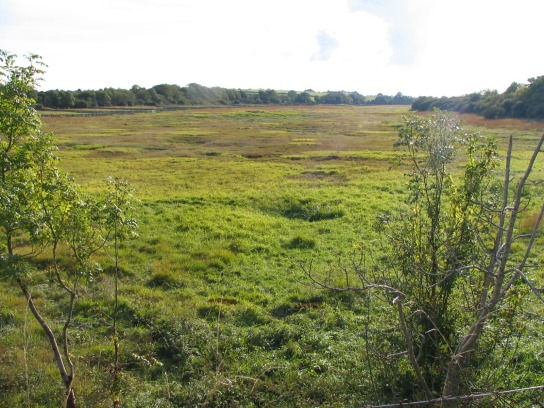
Ballinduff turlough looking southwest along the probable
landing run of Mosquito KA317, September 2007
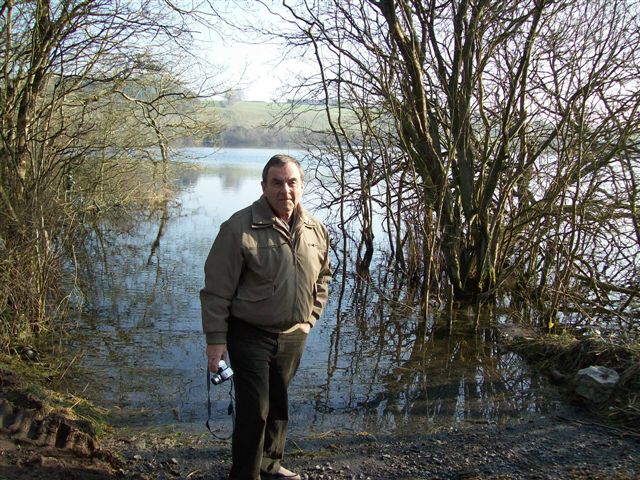
David Ayton at Ballinduff
turlough, February 2008. The site of his father’s fatal crash
landing in June 1944 is in the background below the tranquil
waters of the turlough.
These
scattered items were found in the field during one of visits
by Hayden.
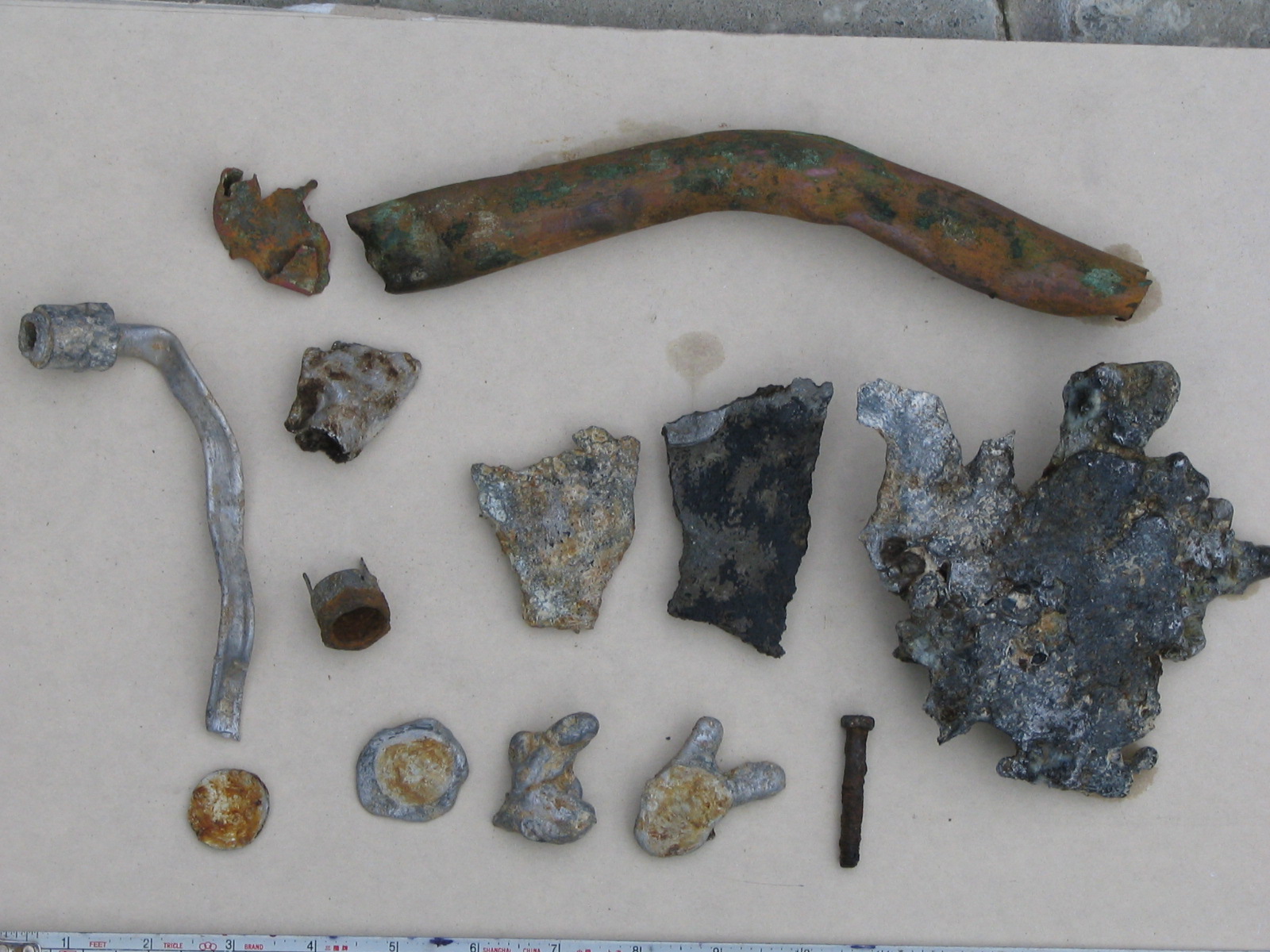
The Air Ministry Form 1178 report carried
the following conclusions on the crash:
FB: Forced landing in a field when running out of
petrol struck pile of stones a/c burst into flames
[Casual factors] A: OP: Loss of power due to petrol
shortage
[Pilot factors] P: CN/C: A/C had been lost for
sometime & was seen over Galway Bay
[Engine factors] E: S/PS/PM/I: Forced landing due to
shortage of petrol poor navigation
[Undercarriage factors] U: OK
[Airframe Factors] A RM: Visual indicator needle ceased to
respond to beacon. W/T conditions were
difficult. Lost contact with RAF Prestwick.
[External factors] X: OK
[Weather factors] W: OK
 The Pilot: Flight Lieut.
Gordon Frederick Ayton, 51167 DFC MiD
The Pilot: Flight Lieut.
Gordon Frederick Ayton, 51167 DFC MiD
Gordon was the son of Frederick and
Gertrude Mary Ayton, of Dereham and husband of Irene
Constance (nee Steer). They had married in 1940. His
brother Wallace Henry Ayton also served in the RAF as a
Wireless Operator/Air Gunner and sadly also was lost with his
crew when Marauder FK155 of 14 Squadron failed to return from
a mission over the Tyrrhenian Sea on 9 May 1943.
Only 26 years old at the time
of his death at Ballinduff, Co. Galway on 28th June 1945,
Gordon Ayton, known as “Ginger” to his colleagues, had served
with distinction in the RAF for over 10 years. In 1935 at the
age of 15 he passed the entrance scholarship to the RAF
College at Cranwell, where he trained as a Wireless Operator
and Air Gunner. Following the outbreak of War in 1939 “Ginger”
Ayton completed his first operational tour, consisting of 30
missions over Germany as a wireless operator in Vickers
Wellingtons, before being accepted for pilot training.
After qualifying for his “Wings” Ayton served as a pilot on
his second operational tour with 37 Squadron in support of the
North African campaign during the autumn of 1942, flying
Wellingtons on raids against enemy airfields and shipping
during the Allied advance from El Alamein to Tunis.
Ayton received his commission while serving in Africa, and
later returned to England to convert on to the DH Mosquito.
For his third operational tour he was posted to 151 Squadron
during April 1944, flying Mosquitos on missions over occupied
Europe, including Ranger operations intended to harass the
enemy by attacking random targets of opportunity such as
airfields and railway depots. Ayton damaged and destroyed a
number of enemy aircraft on the ground including a Ju88, Ju188
and two Ju290 at Mont de Marson airfield. He survived a gear
up flapless belly landing on his base at Predannick, Cornwall
after returning from a raid on a French Power Station when he
was attacked by a German FW190 and hit by anti-aircraft fire
which destroyed the Mosquito’s hydraulic system. 151 Squadron
also carried out attacks on Gestapo buildings in France to
relieve the pressure on the French Resistance, and for his
100th operational sortie on 9th August 1944, Ayton lead a raid
by four Mosquitos on the Gestapo HQ at Chateau Ferron, at
Tonniens on the river Garonne, 25 miles south east of
Bordeaux. This was a precision attack which totally destroyed
the multi-story building, severely disrupting the German
administration in the area and thus aiding the French
Resistance. Ayton later described the raid:
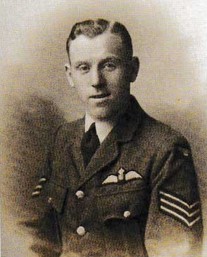 “We
had quite an uneventful trip to the target, except that when
we crossed the enemy coast two flak ships opened up at us
and some ack-ack batteries had a go. F/O Dines brought
us dead over the objective, which was a grand bit of
navigation. I attacked first. One of my 500lb bombs went
straight through the wall and the other through the roof. We
knocked nearly the whole place down. A shower of bricks and
debris went hurtling up in to the air to about 300 feet.
There was not much left for the other Mosquitos to bomb, but
they went in and dropped their bombs in the middle of the
smoke and debris."
“We
had quite an uneventful trip to the target, except that when
we crossed the enemy coast two flak ships opened up at us
and some ack-ack batteries had a go. F/O Dines brought
us dead over the objective, which was a grand bit of
navigation. I attacked first. One of my 500lb bombs went
straight through the wall and the other through the roof. We
knocked nearly the whole place down. A shower of bricks and
debris went hurtling up in to the air to about 300 feet.
There was not much left for the other Mosquitos to bomb, but
they went in and dropped their bombs in the middle of the
smoke and debris."
On 16th August Ayton and F/O Taylor carried out a night
Intruder sortie to Orly, Bretigny, Melun and Coulommiers
airfields. They arrived over Bretigny at an altitude of 3000
ft where they spotted an aircraft in the circuit. Interception
was difficult, but they succeeded in positioning behind the
enemy aircraft, which was identified as a Ju 88. Ayton
attacked with cannon and machine gun fire and the tail section
broke off the Ju 88 which entered a vertical dive and exploded
on impact with the ground. Following this raid, Gordon Ayton
was awarded the Distinguished Flying Cross (DFC) – his
citation read:
“This officer, who is now on this third operational tour,
has completed a very large number of sorties. During his
first tour of duty he was engaged as a Wireless Operator
(Air) on bombing missions to Germany. Later he became a
pilot in the Middle East, making numerous attacks on
airfields, shipping and enemy troops. During his present
tour of duty, Flying Officer Ayton has delivered a number of
effective attacks on enemy airfields in France, which have
resulted in several enemy aircraft being destroyed on the
ground. During his present tour Flying Officer Ayton has
destroyed at least one enemy aircraft in combat and damaged
others.”
By the end of hostilities in Europe on 8th May 1945 Ayton had
completed 128 operational sorties. At the end of his third
operational tour, he transferred to 45 Group RAF Transport
Command at Dorval Airport, Montreal. This unit was staffed
jointly by RAF and RCAF personnel engaged in ferrying Canadian
and U.S. built aircraft across the Atlantic from Canada to the
U.K. Ayton was due promotion to Squadron Leader three weeks
after his untimely death, and would undoubtedly advanced to
higher rank in the RAF had he lived. His remains are interred
at his native village of East Dereham, Norfolk, England
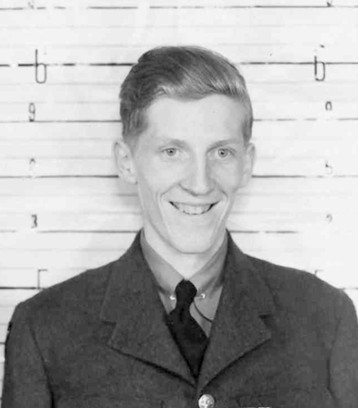 The
Navigator: Flying Officer Hans Raymond Anderson CAN/J.38661
The
Navigator: Flying Officer Hans Raymond Anderson CAN/J.38661
Hans was born on 4 October 1922.
His RAF Ferry Command card lists his place of birth as New
Brunswick. His parents were Christian Sigurd and Kamma
Christa Anderson.
He enlisted in Winnipeg on the 13 April
1942, and his name appears in a list of Winnipeg men published
in the Winnipeg Tribune as having been recruited during that
week. He was granted leave without pay until 9 June 1942
and then posted to No.3 Manning Depot. Another holding posting
was next to No.12 SFTS for guard duty on 1 August 1942.
He was posted to No.2 ITS on 12 September
1942 and finally to No.2 EFTS on 21 November 1942 to begin
pilot training. It would appear that he was not found to be
suitable as a pilot and ceased that training and was posted to
No.1 Composite Training School in Trenton, Ontario on 15
December 1942.
His wartime trade training continued with
a posting to No.4 Wireless School, Guelph, Ontario on 19 March
1943, this would seem to align with the units ORB mention of
the arrival of Course 65 on the 20 March. Following completion
of that his next posting was No.2 Bombing and Gunnery School,
Mossbank, Sask. on 3 October 1943. He graduated and was
commissioned on 22 November 1943.
Following this he was posted to To "Y"
Depot, Halifax, for embarkation overseas on 6 December 1943
and sailed to the UK. He was taken on strength of No.3
Personnel Reception Centre, Bournemouth on 13 December
1943. Between January and September 1944 he served with
10 (O) AFU and 105 (T) OTU. He was posted to No.45 (Air
Transport) Group, Dorval on 27th June 1944.
His crew card shows
him as being at Montreal (Dorval) as of 27 June 1944.
Departed Montreal as crew of Dakota KJ839 on 30 August 1944,
arriving Gander on 31 August 1944; departed Gander 31 August
and arrived Bluie West One that date. At Reykjavik as of 1
September 1944; arrived in UK 4 September 1944.
Returned by boat, Liverpool to Canada (6-13 September
1944). Departed Montreal with Liberator KH212, 21
September 1944, proceeding via Gander, Lagens, Rapat, Cairo
and Khartoum (arriving 28 September 1944). Returned to
New York and Montreal, 1 October 1944 (which suggest return
by air).
His burn injuries
required special treatment and this recorded on the website
of the East Grinstead Museum. The Winnipeg
Tribune published a notice on the crash on 4th July
1945.
Manitoba Flier
Burned When Mosquito Crashes
DUBLIN, July 4 (Reuters) Flt. Lt. H. R. Anderson, of Red
River, member of the R.C.A.F, was severely burned last
Thursday when a twin engined Mosquito crashed In flames
near Gort, Galway, Eire, and killed PO. Gordon
Ayton, a member of the R.A.F., it was disclosed Tuesday.
The aircraft was on its way from Greenland to Scotland.
Following treatment for his injuries in
the UK, Hans was repatriated on the 30th of December
1945. Winnipeg newspapers reported on his arrival with
thirty four other personnel on the SS Scythia in
Halifax. The papers understood he would be sent to
Lachine and then sent on leave.
He was posted to No.8 Repair Depot on 8th
January 1946 thence to No.5 Release Centre on 13 February 1946
and retired 15 February 1946. His retirement papers record him
having scars on his left arm.
Han's Ferry Command crew card, which was not maintained after
December 1944, confirms date of birth and states he was
born in New Brunswick. His permanent address was given
as Bird River, Manitoba and his next of kin, his father, was
at the same location.
He gave the Irish Army his address at the
time of the crash as Suite 11, Douglas Block, Corner of
Grahams and O’Donnells, Winnipeg, Canada.
Hans passed away in Winnipeg in December
2002.
The deHavilland Mosquito FB26
The Mosquito FB 26 was based on the British made DeHavilland
Mosquito Mark VI fighter bomber aircraft and was manufactured
under licence by DeHavilland Canada at Downsville, Ontario.
Powered by two Packard Merlin 225 engines, the Mosquito featured
a unique form of ply and balsa wood sandwich construction and
was known as “The Wooden Wonder”. It’s high speed allowed it to
operate unarmed over enemy territory, and it was used as a light
bomber, fighter bomber, night fighter, reconnaissance aircraft
and even for transportation of VIP passengers who were
accommodated in the cramped bomb bay.
Specifications, Mosquito FB Mk 26
Engines: Two Packard Merlin 225 1620 H.P. V-12 piston
engines
Weight: Empty 14,300 lbs., Max Takeoff 22,300 lbs.
Wing Span: 54ft. 2in.
Length: 40ft. 10.75in.
Height: 15ft. 3in.
Performance:
Maximum Speed: 362 mph (Later photo-recon versions could
exceed 425 mph)
Ceiling: 33,000 ft.
Range: 1,650 miles with full bomb load
Armament: Four 20-mm cannon in nose
Four 7.7-mm (0.303-inch) machine guns in nose
2,000 pounds of bombs, or 1,000 pounds of bombs and eight
rockets
Canadian built Mosquito FB 26’s were prepared for ferry flights
across the Atlantic by the addition of a disposable 121 Imperial
Gallon tank constructed of rubberised material housed in the
bomb bay which would have given a total endurance of about 6
hours. It is probable that KA317 was equipped with a bomb bay
tank which exploded on impact with the stone wall
Sequel, as written by Hayden around 2008
Last July, accompanied by some
fellow enthusiasts, we were able to locate the debris field
and the site of the crash using metal detectors, and recovered
some small fragments from one of the Packard Merlin engines
of KA317. David Ayton visited again from Canada in early
October 2008, but unfortunately the turlough had flooded again
after the extremely wet summer, but I was able to give him
some of the small items recovered from the crash site. He
hopes to return again during 2009 when the turlough is dry.
Because this crash occurred after the
cessation of hostilities in Europe and the relaxation of
censorship of the Irish media, one can find a number of
mentions of the crash in Irish newspapers unlike most such
crashes since early 1942. Most stories published at the
time mistakenly assumed that Gordon Ayton was a member of the
Canadian forces, when he was actually a Royal Air Force
officer.
Both the Connaught Sentinel and Connaught Tribune carried similar stories on the 3rd and 7th of July 1945:
GALWAY PLANE CRASH
Pilot Officer Killed
THE roar of aeroplane engines stopped over Labane about
11.15 p.m. on Thursday, and a sheet of flame lit the
sky as a twin engined Mosquito aircraft burst
into flames and crashed, a heap of wreckage, into a turloch
in a field at Lissatulla, between Labane and Gort.
Pilot Officer Gordon Ayton, of the Canadian Air Force,
was burned beyond recognition, and Flight Lieut. H. W.
Anderson was extensively burned and sustained a broken
wrist.
Guards from Labane and members of the L.D.F. and L.S.F.
from the locality rushed to the scene of the crash and
pulled Flight Lieut. Anderson from the burning machine. They
were unable to reach Pilot. Officer Ayton.
A short time after the machine had crashed all that was
left above the level of the ground was the twisted steelwork
of the engines; the rest of the machine was
completely consumed.
Engine Trouble
The aircraft was on its way from Greenland to Scotland.
and it appears that engine trouble developed over Galway
Bay. It was heard flying over Galway shortly after 10.30
p.m. evidently traveling south. It was heard
soon after over Oranmore, Clarenbridge and Ardrahan.
After the crash two ambulance went out from St. Enda’s
Military Hospital, Galway, in response to a ‘phone call and
took the injured Flight Lieut, and the remains of the dead
Pilot Officer to St. Enda,’s.
The remains of Pilot, Officer Ayton were removed in am
ambulance from St. Enda’s on Saturday morning and brought to
the Border, where they were handed over in the afternoon to
representatives of the Canadian military authorities. The
Irish Army authorities provided a guard of honour at the
Border. An inquest was not considered
necessary.
While outside the realm of Irish
Government censorship, the Belfast Telegraph carried the
following story on 30 Jun 1945:
EIRE ‘PLANE CRASH
R.C.A.F. Officer Burned to Death
A Mosquito aeroplane of the Royal Canadian Air Force
crashed in Co. Galway shortly alter mid night (British time)
on Thursday, and Pilot Officer Gordon Ayton was burned to
death and Flight Lieut. H. W. Anderson severely burned. They
were the only occupants of the aeroplane.
The aeroplane developed engine trouble over Galway Bay,
but managed to fly over Galway city before it fell on
low-lying land.
Firemen and members of the L.D.F. extricated Anderson
from the burning aeroplane but were unable to reach Ayton
whose body was recovered later.
The aeroplane was flying from Greenland to Scotland.
Converted to digital format by Dennis Burke with
addition of information on F/O Anderson, 2024, Dublin and Sligo.
A thank you to the late Hayden Lawford. If you have information
on any of the people listed above, please do contact me at
dp_burke@yahoo.com
